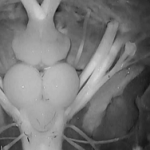The Vocal Brain of Fish

Development of Auditory Processing and Vocal Motor Control
The question of how brain coordinates vocal output is relatively unknown. While human and bird vocal communication is relatively complex, studying simpler models such as fish can provide important insights for understanding the development of fundamental units in the central nervous system for how to build auditory-vocal systems. Feedback from the auditory systems can be critical for the control of vocal behavior in many animals, including humans. In fish, auditory feedback on vocal activity remains unknown. Moreover, the relation between the development of the auditory sense and the vocal differentiation remains uninvestigated in this taxon. Preliminary data shows that the Lusitanian toadfish, Halobatrachus didactylus, uses an unusual sophisticated vocal repertoire for fish (more than five different calls) to communicate during various social contexts and this ability starts remarkably early in life. The aim of this project is threefold: (1) investigate whether and/or how auditory sensitivity, distribution of the inner ear sensory haircells, and auditory processing central units change throughout ontogeny in H. didactylus; (2) study the development of the vocal repertoire, sound generating system (swimbladder), and vocal motor control brain nuclei; and (3) evaluate whether auditory feedback plays a role in shaping vocalizations and vocal neural networks during development.
This work will consist on the first attempt to evaluate the relationship between the development of the auditory and the vocal systems in a fish species and will allow to determine whether both systems have evolved independently or in parallel. As vocal networks in all vertebrates seemed to have evolved from an ancestrally shared brain area originated in fish, we predict that our data will provide valuable insights into the evolutionary history of the brain circuits for complex behaviors such as the use of sound for social communication.
Funded by FDCT, reference 019/2012/A1.
TEAM
Raquel O. Vasconcelos
Ph.D. CoCoordinator from ISE, USJ, Macau
Andreia Ramos
Research Assistant from University of Lisbon, Portugal
Ciara Valdoria
Research Assistant from ISE, USJ, Macau
Patrícia Chaves
Reasearch Assistant from ISPA, Portugal
Paulo J. Fonseca,
Co-investigator from University of Lisbon, Portugal
Joseph A. Sisneros
Co-investigator from University of Washington, WA, USA
